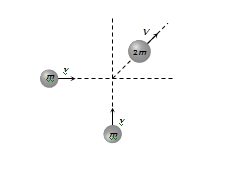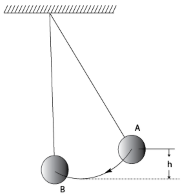11th And 12th > Physics
COLLISIONS MCQs
Total Questions : 30
| Page 1 of 3 pages
Answer: Option D. ->
- 2 mv
:
D
:
D
Change in momentum = m→v2−m→v1=−mv−mv=−2mv
Answer: Option C. ->
Total inelastic
:
C
:
C
By definition of Perfectly Inelastic Collision, the two colliding bodies stick together after collision
Answer: Option C. ->
Move with the same velocity in opposite directions
:
C
According to law of conservation of linear momentum both pieces should possess equal momentum after explosion. As their masses are equal therefore they will possess equal speed in opposite direction.
:
C
According to law of conservation of linear momentum both pieces should possess equal momentum after explosion. As their masses are equal therefore they will possess equal speed in opposite direction.
Answer: Option A. ->
1−e1+e
:
A
:
A
Let the final velocities of the two masses be v1 and v2 By definition,e=v2−v10−4
Conservation of linear momentum,m(u)+0=mv1+mv2
⇒v1+v2=4
∴v1+v2v2−v1=4−e4
v1+v2v1−v2=1e
∴v1v2=1+e1−e
v2v1=1−e1+e
Answer: Option C. ->
23
:
C
23
:
C
m1v1−m2v2=(m1+m2)v
⇒(2×3)−(1×4)=(2+1)v⇒v=23m/s
Answer: Option A. ->
1
:
A
:
A
No energy is lost in perfectly elastic collision. Therefore e = 1
Answer: Option D. ->
e4h
:
D
The velocity attained after a fall through a height h is given by v2=2gh
Thus h∝v2 The velocity after first rebound is ev. Therefore, the height attained after first rebound = e2h. Velocity after second rebound is e2v. Hence the height attained after second rebounds is e4h. Thus the correct choice is (d).
:
D
The velocity attained after a fall through a height h is given by v2=2gh
Thus h∝v2 The velocity after first rebound is ev. Therefore, the height attained after first rebound = e2h. Velocity after second rebound is e2v. Hence the height attained after second rebounds is e4h. Thus the correct choice is (d).
Answer: Option A. ->
Bob A comes to rest at B and bob B move to the left attaining a maximum height h.
:
A
Suppose the bob A acquires a velocity v on reaching the bob B. In a head-on elastic collision between two bodies of the same mass, the velocities are exchanged after the collision. Hence the bob A will come to rest at the lowermost position (occupied by B before collision) and the bob B will move to the left attaining a maximum height h. hence the correct choice is (a).
:
A
Suppose the bob A acquires a velocity v on reaching the bob B. In a head-on elastic collision between two bodies of the same mass, the velocities are exchanged after the collision. Hence the bob A will come to rest at the lowermost position (occupied by B before collision) and the bob B will move to the left attaining a maximum height h. hence the correct choice is (a).
Answer: Option B. ->
1.2 kg
:
B
Since the collision is elastic, both momentum and kinetic energy are conserved. If m is mass of ball Q and v’ its speed after the collision, the law of conservation of momentum gives
2v=2×v4+mv′
Where v is the original speed of ball P. thus
mv′=3v2 or v′=3v2m (i)
The law of conservation of energy gives
12×2×v2=12×2×(v4)2+12mv′2
or mv′2=15v28 (ii)
Using (i) in (ii) we get m = 1.2 kg. Hence the correct choice is (b).
:
B
Since the collision is elastic, both momentum and kinetic energy are conserved. If m is mass of ball Q and v’ its speed after the collision, the law of conservation of momentum gives
2v=2×v4+mv′
Where v is the original speed of ball P. thus
mv′=3v2 or v′=3v2m (i)
The law of conservation of energy gives
12×2×v2=12×2×(v4)2+12mv′2
or mv′2=15v28 (ii)
Using (i) in (ii) we get m = 1.2 kg. Hence the correct choice is (b).


















